Tales of Animals in War Poster
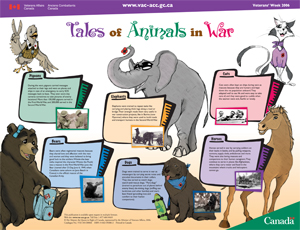
This publication is available upon request in alternate formats.
PDF Version
This poster for Tales of Animals in War features interesting and thought-provoking animal facts that you can read and discuss! Each character on the poster has a relative who served in war. Read their stories in the "Tales of Animals in War" newspaper to learn more about the information found in these fact files!
Pigeons
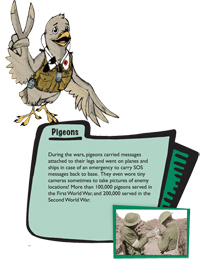
During the wars, pigeons carried messages attached to their legs and went on planes and ships in case of an emergency to carry SOS messages back to base. They even wore tiny cameras sometimes to take pictures of enemy locations! More than 100,000 pigeons served in the First World War, and 200,000 served in the Second World War.
Elephants
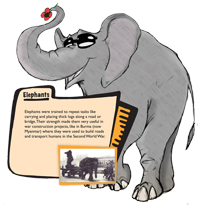
Elephants were trained to repeat tasks like carrying and placing thick logs along a road or bridge. Their strength made them very useful in war construction projects, like in Burma (now Myanmar) where they were used to build roads and transport humans in the Second World War.
Cats
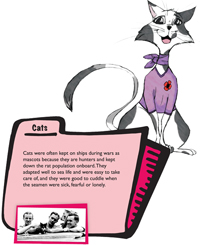
Cats were often kept on ships during wars as mascots because they are hunters and kept down the rat population onboard. They adapted well to sea life and were easy to take care of, and they were good to cuddle when the seamen were sick, fearful or lonely.
Dogs
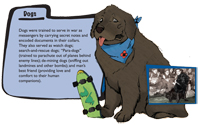
Dogs were trained to serve in war as messengers by carrying secret notes and encoded documents in their collars. They also served as watch dogs; search-and-rescue dogs; "Para-dogs" (trained to parachute out of planes behind enemy lines); de-mining dogs (sniffing out land mines and other bombs); and man's best friend (providing love and comfort to their human companions).
Bears
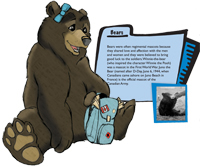
Bears were often regimental mascots because they shared love and affection with the men and women and they were believed to bring good luck to the soldiers. Winnie-the-bear (who inspired the character Winnie the Pooh) was a mascot in the First World War. Juno the Bear (named after D-Day, June 6, 1944, when Canadians came ashore on Juno Beach in France) is the official mascot of the Canadian Army.
Horses
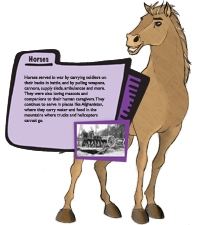
Horses served in war by carrying soldiers on their backs in battle, and by pulling weapons, cannons, supply sleds, ambulances and more. They were also loving mascots and companions to their human caregivers. They continue to serve in places like Afghanistan, where they carry water and food in the mountains where trucks and helicopters cannot go.
- Date modified: